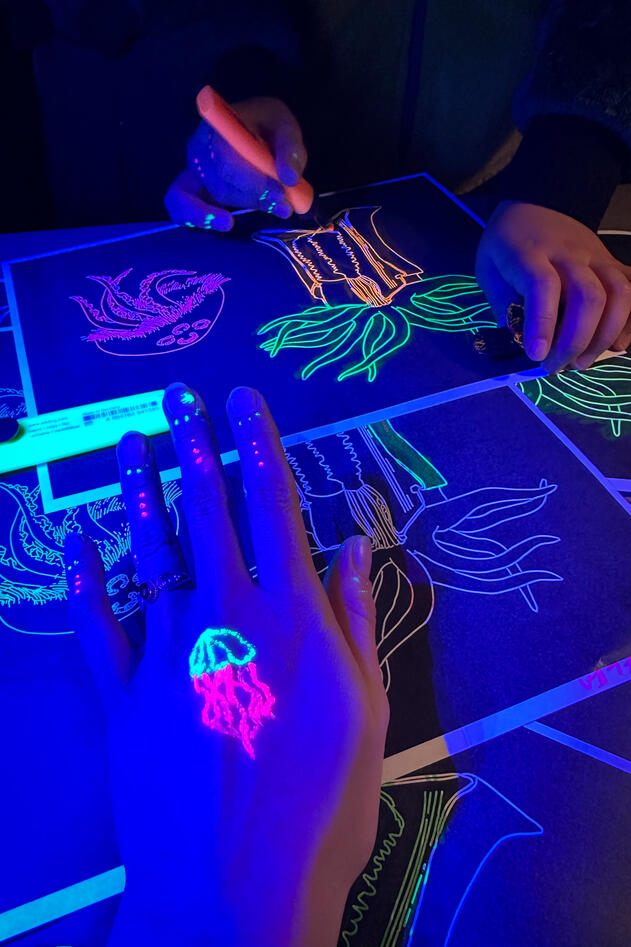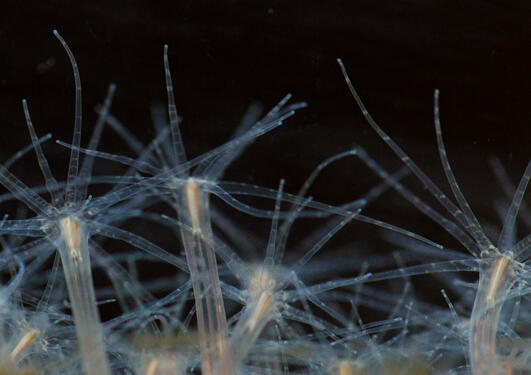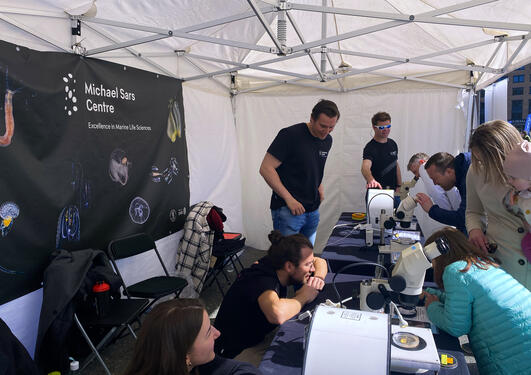A Night of Discovery: Highlights from the Night Walk at the Bergen Aquarium.
Researchers from the Michael Sars Centre engaged visitors with interactive exhibits and offered insights into marine life fostering scientific curiosity and education among guests of all ages.
Main content
Armed with flashlights, around 600 guests attended the Night Walk at the Bergen Aquarium (Akvariet i Bergen) last Friday night where researchers from the Michael Sars Centre at the University of Bergen shared investigations into the impact of noise pollution and displayed various marine organisms including Ciona intestinalis, Oikopleura dioica, and Nematostella vectensis.
Situated in the beautiful Aquarium rotunda, the Chatzigeorgiou Group presented the Deuteronoise project, investigating the impact of noise on marine life through an interactive quiz with different sounds recorded under the ocean's surface. "Some of the kids (and adults) said that they were surprised by marine animal sound production. But they also believed, with no doubt, that noise pollution, like other types of pollutants, influences life in the ocean. For me, this underlines how important our job is," said researcher Sissel Norland. The group's station also highlighted two tunicate species, Oikopleura dioica, and Ciona Intestinalis, with aquariums displaying their various life stages from larvae to adulthood. Children assumed the role of scientists as they peered through microscopes, observing the Ciona larvae in motion. Meanwhile, guests were invited to use magnifying glasses to take a closer look at the millimeter-sized Oikopleura displayed in a tall cylinder.
Some of the kids said that they were surprised by marine animal sound production. But they also believed, with no doubt, that noise pollution, like other types of pollutants, influences life in the ocean. For me, this underlines how important our job is.
- Sissel Norland
Researchers from the Steinmetz Group displayed the sea anemones Nematostella and Aiptasia, from egg to adult. They explained to fascinated visitors that these animals are voracious predators with complex life cycles, despite their jelly-like appearance and lack of a brain. Under UV lights, a magical feature of Aiptasia was revealed as their symbiotic algae glowed red. Young guests were invited to contribute with their interpretation of a glowing anemone using fluorescent paint, and were made aware of the fragility of symbiotic relationships in a changing ocean.
In addition to the displays from the Aquarium staff, a variety of organizations were invited to share their research and their resources with the guests. Bergensavisen offered children the opportunity to make a newspaper cover, Norsk Fjordsalat displayed a variety of seaweed and kelp as food, and Kjempegøy provided an insect hotel decorating workshop.
Akvariet i Bergen Marketing Coordinator Ingvild Nesje spoke about the success of the evening with many children not wanting to go home because of the fun they were having. "We were very pleased that so many people made the trip to the Aquarium and the Night Walk event on Friday. It was a great evening with a focus on the desire to learn. Thank you to everyone who contributed to making this a successful event. We're already looking forward to next year."












